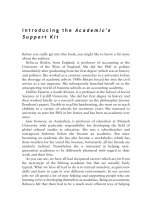ai _ neural network for beginners (part 2 of 3) - codeproject
Bạn đang xem bản rút gọn của tài liệu. Xem và tải ngay bản đầy đủ của tài liệu tại đây (579.27 KB, 12 trang )
Articles » General Programming » Algorithms & Recipes » Neural Networks
AI : Neural Network for beginners (Part 2 of 3)
By Sacha Barber, 29 Jan 2007
Download demo project (includes source code) - 812 Kb
Introduction
This article is part 2 of a series of 3 articles that I am going to post. The proposed article content will be as follows:
1. Part 1 : Is an introduction into Perceptron networks (single layer neural networks).
2. Part 2 : This one, is about multi layer neural networks, and the back propagation training method to solve a non
linear classification problem such as the logic of an XOR logic gate. This is something that a Perceptron can't do.
This is explained further within this article.
3. Part 3 : Will be about how to use a genetic algorithm (GA) to train a multi layer neural network to solve some
logic problem.
Summary
This article will show how to use a multi-layer neural network to solve the XOR logic problem.
A Brief Recap (From part 1 of 3)
Before we commence with the nitty gritty of this new article which deals with multi layer Neural Networks, let just
revisit a few key concepts. If you haven't read Part 1, perhaps you should start there.
Perceptron Configuration ( Single layer network)
The inputs (x1,x2,x3 xm) and connection weights (w1,w2,w3 wm) shown below are typically real values, both
positive (+) and negative (-).
The perceptron itself, consists of weights, the summation processor, an activation function, and an adjustable
threshold processor (called bias here after).
For convenience, the normal practice is to treat the bias as just another input. The following diagram illustrates the
revised configuration.
4.86 (97 votes)
The bias can be thought of as the propensity (a tendency towards a particular way of behaving) of the perceptron to
fire irrespective of it's inputs. The perceptron configuration network shown above fires if the weighted sum > 0, or if
you have into maths type explanations
So that's the basic operation of a perceptron. But we now want to build more layers of these, so let's carry on to the
new stuff.
So Now The New Stuff (More layers)
From this point on, anything that is being discussed relates directly to this article's code.
In the summary at the top, the problem we are trying to solve was how to use a multi-layer neural network to solve
the XOR logic problem. So how is this done. Well it's really an incremental build on what Part 1 already discussed. So
let's march on.
What does the XOR logic problem look like? Well, it looks like the following truth table:
Remember with a single layer (perceptron) we can't actually achieve the XOR functionality, as it is not linearly
separable. But with a multi-layer network, this is achievable.
What Does The New Network Look Like
The new network that will solve the XOR problem will look similar to a single layer network. We are still dealing with
inputs / weights / outputs. What is new is the addition of the hidden layer.
As already explained above, there is one input layer, one hidden layer and one output layer.
It is by using the inputs and weights that we are able to work out the activation for a given node. This is easily
achieved for the hidden layer as it has direct links to the actual input layer.
The output layer, however, knows nothing about the input layer as it is not directly connected to it. So to work out the
activation for an output node we need to make use of the output from the hidden layer nodes, which are used as
inputs to the output layer nodes.
This entire process described above can be thought of as a pass forward from one layer to the next.
This still works like it did with a single layer network; the activation for any given node is still worked out as follows:
Where (wi is the weight(i), and Ii is the input(i) value)
You see it the same old stuff, no demons, smoke or magic here. It's stuff we've already covered.
So that's how the network looks/works. So now I guess you want to know how to go about training it.
Types Of Learning
There are essentially 2 types of learning that may be applied, to a Neural Network, which is "Reinforcement" and
"Supervised"
Reinforcement
In Reinforcement learning, during training, a set of inputs is presented to the Neural Network, the Output is 0.75,
when the target was expecting 1.0.
The error (1.0 - 0.75) is used for training ('wrong by 0.25').
What if there are 2 outputs, then the total error is summed to give a single number (typically sum of squared errors).
Eg "your total error on all outputs is 1.76"
Note that this just tells you how wrong you were, not in which direction you were wrong.
Using this method we may never get a result, or it could be a case of 'Hunt the needle'.
NOTE : Part 3 of this series will be using a GA to train a Neural Network, which is Reinforcement learning. The GA
simply does what a GA does, and all the normal GA phases to select weights for the Neural Network. There is no back
propagation of values. The Neural Network is just good or just bad. As one can imagine, this process takes a lot more
steps to get to the same result.
Supervised
In Supervised Learning the Neural Network is given more information.
Not just 'how wrong' it was, but 'in what direction it was wrong' like 'Hunt the needle' but where you are told 'North a
bit', 'West a bit'.
So you get, and use, far more information in Supervised Learning, and this is the normal form of Neural Network
learning algorithm. Back Propagation (what this article uses, is Supervised Learning)
Learning Algorithm
In brief, to train a multi-layer Neural Network, the following steps are carried out:
Start off with random weights (and biases) in the Neural Network
Try one or more members of the training set, see how badly the output(s) are compared to what they should be
(compared to the target output(s))
Jiggle weights a bit, aimed at getting improvement on outputs
Now try with a new lot of the training set, or repeat again,
jiggling weights each time
Keep repeating until you get quite accurate outputs
This is what this article submission uses to solve the XOR problem. This is also called "Back Propagation" (normally
called BP or BackProp)
Backprop allows you to use this error at output, to adjust the weights arriving at the output layer, but then also allows
you to calculate the effective error 1 layer back, and use this to adjust the weights arriving there, and so on, back-
propagating errors through any number of layers.
The trick is the use of a sigmoid as the non-linear transfer function (which was covered in Part 1. The sigmoid is used
as it offers the ability to apply differentiation techniques.
Because this is nicely differentiable – it so happens that
Which in context of the article can be written as
delta_outputs[i] = outputs[i] * (1.0 - outputs[i]) * (targets[i] - outputs[i])
It is by using this calculation that the weight changes can be applied back through the network.
Things To Watch Out For
Valleys: Using the rolled ball metaphor, there may well be valleys like this, with steep sides and a gently sloping floor.
Gradient descent tends to waste time swooshing up and down each side of the valley (think ball!)
So what can we do about this. Well we add a momentum term, that tends to cancel out the back and forth
movements and emphasizes any consistent direction, then this will go down such valleys with gentle bottom-slopes
much more successfully (faster)
Starting The Training
This is probably best demonstrated with a code snippet from the article's actual code:
/// <summary>
/// The main training. The expected target values are passed in to this
/// method as parameters, and the <see cref="NeuralNetwork">NeuralNetwork</see>
/// is then updated with small weight changes, for this training iteration
/// This method also applied momentum, to ensure that the NeuralNetwork is
/// nurtured into proceeding in the correct direction. We are trying to avoid valleys.
/// If you don't know what valleys means, read the articles associated text
/// </summary>
/// <param name="target">A double[] array containing the target value(s)</param>
private void train_network(double[] target)
{
//get momentum values (delta values from last pass)
double[] delta_hidden = new double[nn.NumberOfHidden + 1];
double[] delta_outputs = new double[nn.NumberOfOutputs];
// Get the delta value for the output layer
for (int i = 0; i < nn.NumberOfOutputs; i++)
{
delta_outputs[i] =
nn.Outputs[i] * (1.0 - nn.Outputs[i]) * (target[i] - nn.Outputs[i]);
}
// Get the delta value for the hidden layer
for (int i = 0; i < nn.NumberOfHidden + 1; i++)
{
double error = 0.0;
for (int j = 0; j < nn.NumberOfOutputs; j++)
{
error += nn.HiddenToOutputWeights[i, j] * delta_outputs[j];
}
delta_hidden[i] = nn.Hidden[i] * (1.0 - nn.Hidden[i]) * error;
}
// Now update the weights between hidden & output layer
for (int i = 0; i < nn.NumberOfOutputs; i++)
{
for (int j = 0; j < nn.NumberOfHidden + 1; j++)
{
//use momentum (delta values from last pass),
//to ensure moved in correct direction
nn.HiddenToOutputWeights[j, i] += nn.LearningRate * delta_outputs[i] * nn.Hidden[j];
}
}
// Now update the weights between input & hidden layer
for (int i = 0; i < nn.NumberOfHidden; i++)
{
for (int j = 0; j < nn.NumberOfInputs + 1; j++)
{
//use momentum (delta values from last pass),
//to ensure moved in correct direction
nn.InputToHiddenWeights[j, i] += nn.LearningRate * delta_hidden[i] * nn.Inputs[j];
}
}
}
So Finally The Code
Well, the code for this article looks like the following class diagram (It's Visual Studio 2005 C#, .NET v2.0)
The main classes that people should take the time to look at would be :
NN_Trainer_XOR : Trains a Neural Network to solve the XOR problem
TrainerEventArgs : Training event args, for use with a GUI
NeuralNetwork : A configurable Neural Network
NeuralNetworkEventArgs : Training event args, for use with a GUI
SigmoidActivationFunction : A static method to provide the sigmoid activation function
The rest are a GUI I constructed simply to show how it all fits together.
NOTE : the demo project contains all code, so I won't list it here.
Code Demos
The DEMO application attached has 3 main areas which are described below:
LIVE RESULTS Tab
It can be seen that this has very nearly solved the XOR problem (You will probably never get it 100% accurate)
TRAINING RESULTS Tab
Viewing the training phase target/outputs together
Viewing the training phase errors
TRAINED RESULTS Tab
Viewing the trained target/outputs together
Viewing the trained errors
It is also possible to view the Neural Networks final configuration using the "View Neural Network Config" button. If
people are interested in what weights the Neural Network ended up with, this is the place to look.
What Do You Think ?
That's it. I would just like to ask, if you liked the article, please vote for it.
Points of Interest
I think AI is fairly interesting, that's why I am taking the time to publish these articles. So I hope someone else finds it
interesting, and that it might help further someone's knowledge, as it has my own.
Anyone that wants to look further into AI type stuff, that finds the content of this article a bit basic should check out
Andrew Krillovs articles, at Andrew Krillov CP articles as his are more advanced, and very good. In fact anything
Andrew seems to do, is very good.
History
v1.0 24/11/06
Bibliography
Artificial Intelligence 2nd edition, Elaine Rich / Kevin Knight. McGraw Hill Inc.
Artificial Intelligence, A Modern Approach, Stuart Russell / Peter Norvig. Prentice Hall.
License
This article has no explicit license attached to it but may contain usage terms in the article text or the download files
themselves. If in doubt please contact the author via the discussion board below.
A list of licenses authors might use can be found here
About the Author
Sacha Barber
Software Developer (Senior)
United Kingdom
Member
I currently hold the following qualifications (amongst others, I also studied Music Technology and Electronics, for my
sins)
- MSc (Passed with distinctions), in Information Technology for E-Commerce
- BSc Hons (1st class) in Computer Science & Artificial Intelligence
Both of these at Sussex University UK.
Award(s)
I am lucky enough to have won a few awards for Zany Crazy code articles over the years
Microsoft C# MVP 2012
Codeproject MVP 2012
Microsoft C# MVP 2011
Codeproject MVP 2011
Microsoft C# MVP 2010
Codeproject MVP 2010
Microsoft C# MVP 2009
Codeproject MVP 2009
Permalink | Advertise | Privacy | Mobile
Web01 | 2.6.121031.1 | Last Updated 30 Jan 2007
Article Copyright 2006 by Sacha Barber
Everything else Copyright © CodeProject, 1999-2012
Terms of Use
Microsoft C# MVP 2008
Codeproject MVP 2008
And numerous codeproject awards which you can see over at my blog
Comments and Discussions
36 messages have been posted for this article Visit />Network-for-beginners-Part-2-of-3 to post and view comments on this article, or click here to get a print view
with messages.









